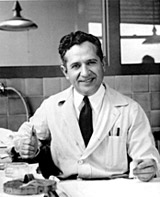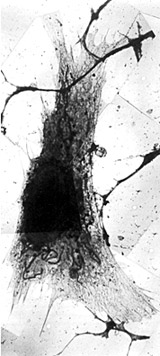Cell Fractionation, Biochemistry, and Electron Microscopy: The Birth of Modern Cell Biology

Claude, Albert
Courtesy of the Rockefeller Archive Center
In the 1930s and 1940s, Albert Claude (1899-1983) pioneered techniques of cell fractionation by differential centrifugation. When, in the early 1940s, electron microscopes became available, he was the first to use this new technology to look at cells. With these combined approaches, scientists' view of the cell was transformed: what had seemed watery and formless was revealed as having an internal organization whose structure, biochemistry, and function could be investigated. Claude and colleagues ushered in this "coming of age of the cell," as he put it. They created the first image of a whole cell using an electron microscope. Claude also identified mitochondria as the cell's powerhouses, rich in enzymes responsible for oxygen uptake, and he discovered the lace-like endoplasmic reticulum. In 1974 he shared the Nobel Prize with Christian de Duve (1917- ) and George E. Palade (1912-2008) for their "discoveries concerning the structural and functional organization of the cell."
Claude joined the Rockefeller cancer laboratory of James B. Murphy in 1929, with the goal of using biochemical methods to isolate the Rous sarcoma virus. At the time, scientists still debated whether this tumor-causing agent, discovered in 1911 at Rockefeller by Peyton Rous, was a virus. In order to isolate the agent Claude used a mortar and pestle to gently break open infected cells, then he centrifuged the contents to separate sub-cellular components by their density into "fractions" that could then be analyzed biochemically. Claude worked for several years to improve the technique. In the course of isolating and purifying the Rous agent, he also isolated mitochondria and discovered particles that came to be called microsomes.

This electron micrograph was the first one to show an intact cell. Courtesy of the Rockefeller Archive Center
In 1943 Claude published an article in Science that prompted a collaboration with Ernest Fullam at the Interchemical Laboratory in New York, which possessed one of the few electron microscopes in the country at the time. In the meantime, Keith Porter (1912-1997) had joined Claude's research group and developed a method of culturing cells (chicken embryo fibroblasts) so that they were thin enough to be imaged with the electron microscope. Their collaboration resulted, in 1945, in the first image of an intact cell by electron microscopy, an effort to see where microsomes and other structures were located in the cell. This image was so rich in structure and information that Palade later termed it the "birth certificate" of the field of cell biology.
Other scientists came to work in Claude's laboratory, where fundamental contributions would make Rockefeller the hub of the emerging discipline of cell biology. Notably, George Palade, arriving in 1947, improved and extended the fractionation and imaging techniques first used by Claude, and went on, among other things, to discover the ribosome and chemically characterize the secretory pathway. In addition, essential to progress in electron microscopy of cells was a tool invented by Porter and Rockefeller instrument maker Joseph Blum: a microtome that could create ultra-thin slices of biological material. Claude returned to Belgium in 1949.
Albert Claude received the MD from the University of Liege, Belgium (1928). After a year in Berlin at the Institute für Krebsforschung, and then at the Kaiser Wilhelm Institute, Dahlem, in the laboratory of tissues culture of Albert Fischer, he joined the Rockefeller laboratory of James B. Murphy in 1929. He remained at Rockefeller until 1949, when he became director of the Jules Bordet Institute at the University of Brussels. In addition to the Nobel Prize, Claude's achievements were recognized by the Medal of the Belgian Academy of Medicine, the Louisa G. Horowitz Prize of Columbia University, and the Paul Ehrlich and Ludwig Darmstaedter Prize of Frankfurt. In addition, Claude was a full member of the Belgian and French academies of science and an honorary member of the American Academy of Arts and Sciences. Other honors included the Order of the Palmes Académiques of France, the Grand Cordon of the Order of Léopold II, and the Prix Fonds National de la Recherche Scientifique from Belgium.
Selected Publications
Claude A. The constitution of protoplasm. Science, 1943, 97: 451-456
Claude A and Fullam EF. 1945. An electron microscope study of isolated mitochondria:
Methods and preliminary results. J Exp Med 81: 51-62
http://jem.rupress.org/cgi/reprint/81/1/51
Porter KR, Claude A, and Fullam EF. A study of tissue culture cells by electron microscopy: Methods and preliminary observations. J Exp Med, 1945, 81:233-246
http://jem.rupress.org/cgi/reprint/81/3/233
Claude A and Fullam EF. The preparation of sections of guinea pig liver for electron microscopy. J Exp Med, 1946, 83: 499-503
http://jem.rupress.org/cgi/reprint/83/6/499
Claude A. Fractionation of mammalian liver cells by differential centrifugation: I. Problems, methods, and preparation of extract. J Exp Med, 1946, 84: 51-59
http://jem.rupress.org/cgi/reprint/84/1/51
Claude A. Fractionation of mammalian liver cells by differential centrifugation: II. Experimental procedures and results. J Exp Med, 1946, 84: 61-89
http://jem.rupress.org/cgi/reprint/84/1/61
Claude A. 1950. Studies on cells: Morphology, chemical constitution, and distribution of biochemical functions. Harvey Lectures, 1947-1948, 43: 121-164
Further Reading
Palade GE. Albert Claude and the beginnings of biological electron microscopy. J Cell Biol, 1971, 50: 5D-19D
Moberg CL. The electron microscope enters the realm of the intact cell. J Exp Med, 1995, 181: 829-837
http://jem.rupress.org/cgi/reprint/181/3/831
Moberg CL. James B. Murphy, the Rous sarcoma agent, and origins of modern cell biology. In Stapleton DH ed., Creating a Tradition of Biomedical Research: Contributions to the History of The Rockefeller University (Rockefeller University Press, 2004).
de Duve C and Palade GE. Albert Claude, 1899-1983. Nature, 1983, 304: 588
Claude A. Concentration and purification of chicken tumor 1 agent. Science, 1938, 87: 467-468
Claude A. Chemical composition of the tumor-producing fraction of chicken tumor 1. Science, 1939, 213-214
Rasmussen N. Picture control: The electron microscope and the transformation of biology in America, 1940-1960. Stanford Univ Press, 1999
Bechtel W. Discovering cell mechanisms: The creation of modern cell biology. Cambridge Univ Press, 2006
Links
Nobel Prize in Physiology or Medicine, 1974
http://nobelprize.org/nobel_prizes/medicine/laureates/1974/index.html
